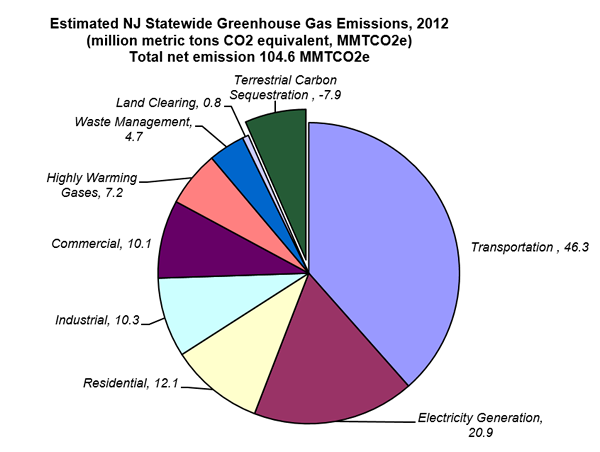There is a critical link between transportation fuel usage, air quality, and climate. In New Jersey, the transportation sector is the largest source of greenhouse gas emissions. Transportation-related energy use accounts for about 40 percent of total statewide greenhouse gas emissions with on-road gasoline consumption representing the majority of those emissions:

Strategies for reducing greenhouse gas emissions in the transportation sector include: making vehicles more energy efficient through technology advances; reducing the carbon content of transportation fuels by using alternative fuels such as electricity, natural gas, biofuel and hydrogen; reducing the number of miles that vehicles travel; and, improving the efficiency of the transportation network.
These same strategies also reduce criteria pollutants and improve New Jersey’s air quality and public health. This is important, as mobile sources are the largest source of air pollution in the State. The Bureau of Mobile Sources develops programs and implements strategies to reduce emissions of criteria pollutants and air toxics from mobile sources (on-road and non-road) operating in the State. Strategies to reduce emissions from gasoline vehicles include the Gasoline Inspection and Maintenance Program; and the Low Emission Vehicle Program.
While emissions from individual cars are relatively low, there are millions of diesel and gasoline vehicles travelling in and through New Jersey every day emitting thousands of tons of pollutants including particulate matter, oxides of nitrogen, air toxics and greenhouse gases. Every year, hundreds of New Jerseyans die prematurely and suffer heart and lung illnesses due to fine particulate matter, commonly called soot. New Jersey now meets USEPA particulate standards. Increased use of compressed natural gas and liquefied natural gas will reduce these numbers further, particularly in urban areas where people are most impacted by criteria pollutants. New Jersey needs to expand its pipeline capacity to facilitate increased use of these fuels.
For more information on Transportation, see the Bureau of Mobile Sources page at http://www.nj.gov/dep/stopthesoot/
|